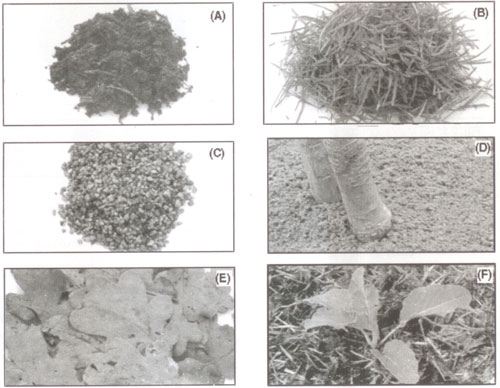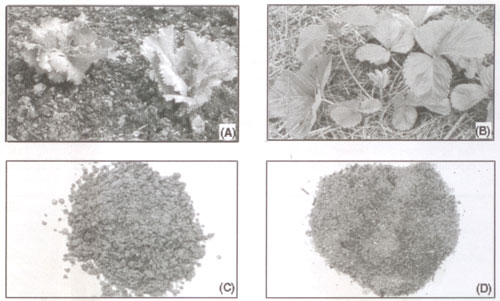Types of Mulch
There are two basic types: loose organic and non-organic, such as peat or gravel; and impenetrable or impermeable sheet types such as carpet or plastic. The mulches in these two groups are listed below alphabetically, with notes about advantages or problems specific to each.Loose Organic and Non-Organic Mulches
-
Bark Products: They are rapidly replacing peat for ornamental mulches, mainly because they are a sustainable resource, whereas peat is not. Bark of white pine, silver maple, walnut, sitka spruce and Douglas fir is processed into different grades, from a powder replacing peat in compost to large pieces the size of two fingers. The larger-textured bark chips are very long- lasting, provide plentiful holes for creatures to live in and allow aeration of the soil underneath more than do the finer grades. The problem, other than cost, is that bark products contain phytotoxic oils that poison many plants, and these have to be removed by careful composting before application. Added dangers from raw bark are animal pests and honey fungus (Armillariia), which is destroyed by shredding and composting. Bark products contain some nutrients, less nitrogen and magnesium but more calcium than sphagnum peat; the hardwood barks contain more nutrients than softwood. Softwoods are more acidic than hardwoods: both are in the range 3.5 to 6.5 pH, but the hardwoods require no lime when composted, as the pH rises, while the softwoods require the addition of chalk at 6 lb (3 kg) per cubic yard/metre.
-
The short-term effect of composted bark pH and nutrients on the soil is slight where the pieces are large, but with the finer grades the breakdown is rapid enough to add fertility, and also to incur some nitrogen robbery if the bark is mixed into the soil. It is fairly expensive but best for the permanent mulching of ornamental areas.
-
Cocoa bean shells are very expensive and have much the same use as coarse-textured bark, being most suited to undisturbed ornamental areas. In wet climates they can cake and become covered with mould, so may not be as attractive after a few weeks, though it helps to mix them half and half with bark of the same grade.
-
Coffee grounds and tea leaves are both unavailable in quantity except near factories. They dry out quickly, are similar to peat in appearance, acidic and with higher levels of nutrients. They can be used around most plants at an inch or so thick and incorporated afterwards, where they will be loved by the worms.
-
Tea leaves contain high levels of aluminium, traditionally utilized for blueing hydrangeas.
-
Dust mulches are the top layer of the soil, frequently and thoroughly hoed to produce a powdery surface. You should make sure that all cracks and crevices are filled. These mulches are primarily intended to keep the soil moist by preventing evaporation; weed control comes from the hoeing. Though they cost nothing, dust mulches can be labour-intensive and rain will cause crusting of the surface, requiring more hoeing. They are useful for early crops such as asparagus. ; -
-
Feather waste is an unusual material, available only near poultry-processing farms, though small quantities can be obtained from recycled bedding. It contains 14% nitrogen in a fairly slow-release form, which can be beneficial but may over-stimulate some plants. It blows about badly and needs to be sprayed with water to settle it. The worst problem is the horrible smell from wet feathers in hot weather. Feather waste may cause disease problems: if packed up in a wet state against bark or stems it can cause rotting.
-
Flax: An alternative to peat, fibrous straw is ground and composted with bark to produce a relatively sterile material, pleasant to handle, with a pH of 6.5. Nutrient levels are not high but the amount of potassium is significant and may make this material of use for vegetable-bed mulching and under soft fruit.
-
Grass clippings are one of the most easily available mulches, underrated principally because of people's experience with smell rotting masses when clippings are continually dumped in one spot. Grass clippings can be used satisfactorily in most areas of the garden. They provide their own nitrogen if incorporated fresh, but may cause nitrogen robbery after long drying.
-
Gravel is pleasant to look at, easy to apply, long-lasting, cheap, and less prone to bird disturbance than many other materials. It may contain lime or e*ven salt, so check this before applying it to sensitive plants. It allows drainage and plentiful aeration. Gravel is most suitable as a permanent rather than a temporary cover. Gravel is surprisingly good at germinating seeds that fall on to it. Once they emerge as weedlings they should be flame- gunned or raked; left longer, they will be harder to eradicate.
-
Hop waste can be used as an attractive mulch resembling a finer grade of bark. As it dries quickly and is then light it may be kept in place with some chipped bark. The waste does not contain much intrinsic nutrient value, though its protein and carbohydrate content means it rapidly decays and adds greatly to the microbial biomass.
-
Leaves and leaf-mould should be secured as much as possible. Leaves make good mulches but blow around, so they need anchoring with grass clippings, sand or chipped bark, or must be covered with a net or some form of sheet mulch. They are probably the best mulch for protecting dormant plants through the winter, keeping them warm and dry. Leaf-mould resembles peat and is very pleasing; it contains many plant foods in the most nutritious form for mulching. Different leaves have different value. Evergreen leaves, which are resistant to decay, can be used as a mulch, though as they often have phytotoxic effects they are best used under their own kind in the shrub border. Holly leaves are supposed to repel moles and mice, but will also repel fingers for many years. Yew is so poisonous that it should not be left where children may pick it up. Leaf-mould may introduce weed seeds even after it has been stacked for years.
-
Manures are best in the spring, as when spread in the autumn they lose nutrients through leaching. Covering the mulch with plastic sheet will prevent this and aid its breakdown. Putting the garden to bed in the autumn like this gives good soil conditions for the spring but precludes green manuring. The high nutrient level means it is possible to overfeed the crop, so manures may be better combined with materials of lower value such as straw. Orchard trees, asparagus, blackcurrants and raspberries, leeks and potatoes will gain most from these rich mulches.
-
Mushroom compost is also used in all areas of the garden. It is probably the most practical all-round mulch because it is widely available, usually free of weed seeds, inexpensive, visually not unappealing and pleasant to handle. As lime and gypsum are added during mushroom-growing it may vary from an acid to a very alkaline pH. Care needs also to be taken against the risk of pesticide residues, as many chemicals are used against mushroom flies.
-
Peat has little nutrient value. It is an effective soil conditioner and has good moisture-holding properties. The finer-textured sedge peat is less acidic than Sphagnum or moss peat.
-
Pine needles are also used as mulch for strawberries, as they reputedly improve the flavour and may discourage slugs and snails.
-
Sand is one of the cheapest mulches, though rarely used. Sharp sand is preferable to the finer builder's sand. It allows more aeration. In many ways sand is similar to gravel, with no nutrient value and little effect on pH unless it contains some chalk.
-
Sawdust contains only half the nutrients of straw, is slow to break down and causes nitrogen robbery, so should not be incorporated into the soil unless and until it has broken down to a brown 'soil' and worms are found in it. Softwood sawdust take longer than hardwoods to decompose.
-
Stones are also used like gravel. They are more effective at condensing dew and throwing up heat. If the stone is crushed and has sharp surfaces then it will discourage slugs and snails. The larger the stones the less effective they are at stopping weeds, unless there is a thick layer.
-
Straw (and hay) is the commonest bulk mulching material, especially for soft fruit, and for keeping strawberries clean. Straw is low in nutrient value but does not cause nitrogen robbery. Straw makes an excellent quick-drying pathway and is a mulch in most parts of the productive garden. In the vegetable garden it is more suitable for larger transplants, as the birds more it around and it can smother seedlings. When used as a temporary mulch it causes a weed problem afterwards
Impermeable and/or Impenetrable Mulches
These kind of mulch have no nutrient value or addition to the soil organic content. They offer similar physical benefits to loose mulches. One thin sheet of old carpet or plastic can replicate the water retention of several inches of a loose mulch. They have insulation effect. The weed control is far superior and the cost can be lower. Following are the impermeable and/or impenetrable mulches:- Old carpet is usually available free, but not all types are suitable. Foam and rubber backings have a tendency to flake off in bits which spread, and these may contain undesirable chemicals. Old natural-fibre carpets are the best as they eventually rot, so can be left in place. All synthetic carpets last lor years, making them excellent for mulching pathways.
- Newspaper and cardboard are impractical on their own, as they are too prone to blow away and once wet are soon broken up or penetrated by weeds. They can e useful underneath loose mulches, as they stop the soil being mixed in with the mulch and thus allow a thinner layer. Commercial papers are available, though expensive. They are most wallpaper can be as effective. Take care not to use waxed or coloured paper as these may be contaminated with chemical. Newspaper is now mostly chlorine-freehand there is no danger of lead from think any more.
- Plastic sheets are becoming available in rapidly increasing variety to meet different requirements, the main ones being weed suppression, moisture retention and soil warming.
- Impermeable clear plastic (polythene) is primarily a soil warmer. As such, it will also encourage weeds unless covered by a loose mulch.
- Impermeable opaque plastic (polythene), usually black, function much like carpet, effective at stopping light, tough enough to ;>.op weeds. Impermeable sheet, while excluding air, can still allow the entry of water, which can be sucked in uneager the plastic from the surrounding soil. Large areas of plastic may thus produce anaerobic conditions and a loss of favourable microlife. Puncturing plastic sheets with a fork will allow air through but may also encourage weeds. Plastic sheets are especially useful for establishing trees and shrubs, as they provide the ideal moist, weed-free conditions for the first few years before breaking down. Vegetables can be transplanted through slits in plastic sheets, reducing weeding and watering This is especially beneficial to leafy types that are easily spoiled by dirt such as lettuce and spinach.
 |
| Fig. 5.4: (A) Garden compost, (B) Grass clippings, (C) Gracel, (D) Hop waste, (E) Leaves, (F) Manure. |
 |
| Fig. 5.5: (A) Mushroom compost, (B) Pine needles, (C) Sharp sand, (D) Sawdust. |
TABLE 5.2
Types and uses of mulchesClick to view Table (Approx. 330KB) - opens a new window
Click to download a more clear image Table (Approx. 323KB)




